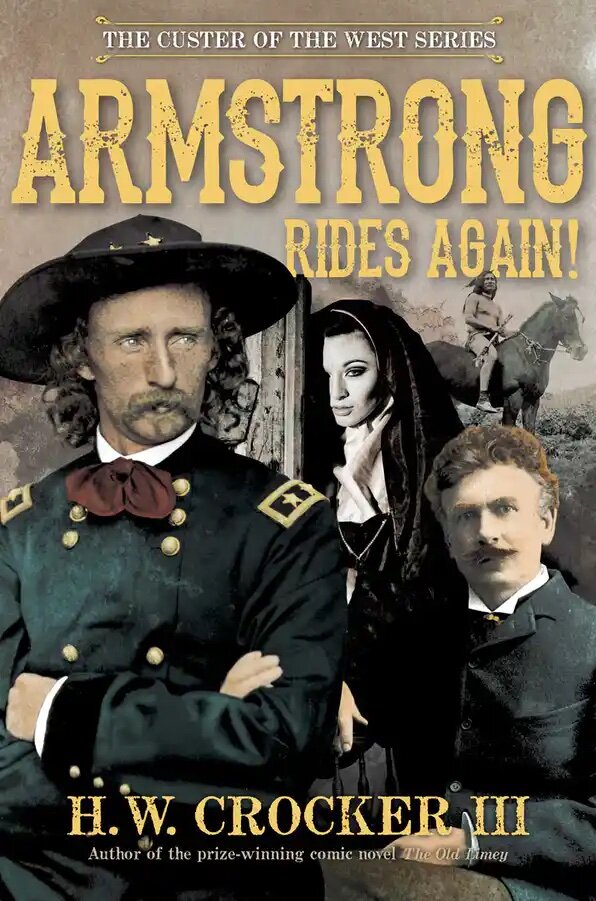One of the pleasures of working for a venerable publishing house with an attic full of musty files is digging through long forgotten correspondence. A few years ago, I was engaged in just such an endeavor and came upon a bit of historical gold.
Libbie Custer, George Armstrong Custer’s widow, lived to the age of ninety. Near the end of her life, from 1930 to 1933, she conducted a correspondence with an antiquarian bookseller in Chicago named Oscar Gruenwald. That correspondence eventually fell into the hands of Henry Regnery, who founded Regnery Publishing in Chicago in 1947. To my astonishment, filed amongst the letters between Gruenwald and Libbie Custer were several bound sheaths of papers. Opening these up, I discovered that they were epically long letters from Custer to his wife.
Custer fancied himself a writer, and these were book-length epistles that he had sent her with the instruction that she should publish them after his death—and this is the truly remarkable part: he wrote these letters after the Battle of the Little Bighorn. In fact, it is entirely unclear when he died, or even if he had died by 1933.
The first letter was published a couple of years ago under the title Armstrong, which was Custer’s posthumous nom de guerre, and revealed how he had survived his alleged “last stand” and had taken on a role as a frontier marshal and soldier of fortune. Because we could not forensically prove that these papers were what they purported to be—and because we did not want the embarrassment of a possible “Hitler’s Diaries” situation, where they would be discovered to be forgeries—we published the letter as “fiction,” and rather than list Custer as the author, that credit was given to me, because I could do interviews, and Custer couldn’t.
We’re now publishing the second letter under the title Armstrong Rides Again! (a rubric we thought would attract serious historians). If the first book was an historical revelation, this one is something of a political shocker, as Custer reveals his involvement in a Latin American civil war with eerie parallels to our own contentious politics in the United States.
Custer was a conservative Democrat, the “Boy General” of the Union Army, but well-disposed to Southerners, a unifying figure in that regard, and sometimes rumored as a possible presidential candidate (he and the Republican president at the time of the Little Bighorn, General U.S. Grant, did not get along for a variety of reasons). Had a political future awaited him— and if Armstrong Rides Again! is any indication—Custer might have been a nineteenth century version of Ronald Reagan. (Ronald Reagan portrayed Custer in the 1940 movie Santa Fe Trail opposite Errol Flynn as J.E.B. Stuart. Flynn, of course, went on to give us the definitive portrayal of Custer in They Died with Their Boots On in 1941).
Armstrong Rides Again! touches on strategy, tactics, politics, and religion (the little- known figure of Father Ricardo Goncalves, Catholic priest, friend of the Confederate naval officer Matthew Fontaine Maury, and early advocate of the submarine, is especially interesting). Much of what is discussed in this letter is of strikingly modern relevance—indeed, the war in which Custer fights is very much on a par with what might have happened had the MAGA vs. Marxism rhetorical battles of recent years been fought out as real battles within a Latin American monarchy.
Beyond that, we sometimes forget the intellectual battles of the nineteenth century that carry on today. In one remarkable passage, Custer quotes the Latin American strongman he serves, El Caudillo, meeting with his political advisors and eviscerating the theory of evolution.
“You’ve heard of this theory of evolution? Father Goncalves disproved it by a simple experiment. Darwin—and I have studied him closely—believes that through a miracle, which he calls ‘time,’ you can turn a fish into a frog, a frog into a lizard, a lizard into an eagle, an eagle into a monkey, and a monkey into a man. I might have the sequence slightly wrong, but it’s something like that; it’s about adaptation over time. But it doesn’t work. I am a farmer, Father Goncalves is farmer, and every farmer knows you can take breeding only so far. Breed a horse and a donkey and you get a mule, not a tiger or a rat—and I don’t care how long you do it. But Father Goncalves, being a scientist, gave Darwin’s theory a try. He put pigs in trees around his farm to see if they would adapt to their environment and grow wings—and did they? No, they merely fell splat on the ground and died. We turned them into ham for the Navy.”
Many other topics are dealt with in this letter with similar sophistication, which one might find surprising, coming from the pen of a nineteenth century soldier.
Given the times in which we live, I should supply this trigger warning. There are plenty of triggers pulled in the book. Gunplay, war, romance (of a cisgender kind), chivalry, and a vicious attack dog all play prominent roles. But as an historical artifact, I think any reader interested in American history, politics, and military affairs will find Armstrong Rides Again! invaluable.


Comments